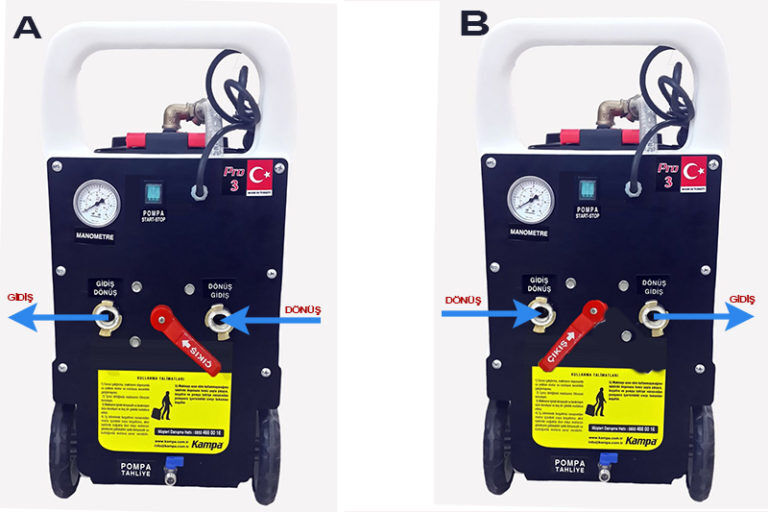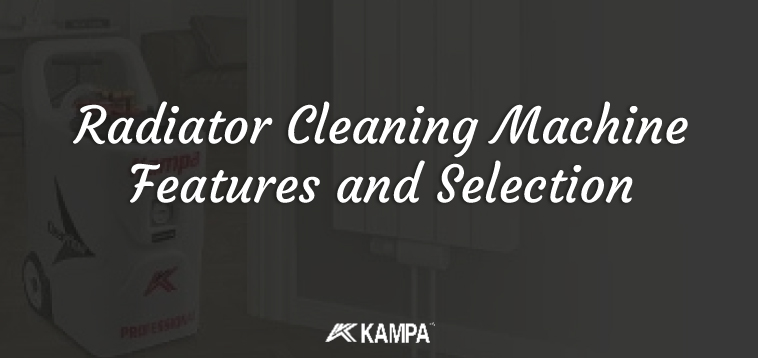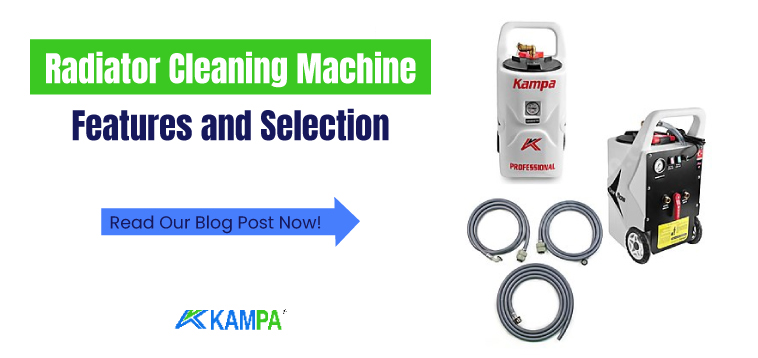Radiator Cleaning Machine Features and Selection
In this article, we will give information about radiator cleaning machine selection. Since many customers are not fully informed about the features of the machines, they have difficulties in making a choice and they cannot decide which machine they should buy.
There are currently 4 different models for plumbing cleaning machines;
Kampa Pro-1 radiator cleaning machine: 4 bar 60 liters per minute
Kampa Pro-2 : 4 bar 60 liters per minute 2500 Watt heater with resistance
Kampa Pro-3 : 4 bar 60 liters per minute Bidirectional cleaning
Kampa Pro-4 : 4 bar 60 liters per minute 2500 Watt heater with resistance and two-way cleaning
The 4 models we have written the name of have a pressure of 4 bar and a water flow rate of 60 liters/minute. What does this mean 4 bar pressure means a power that can carry the liquid vertically to a height of 40 meters.
This means that the radiator cleaning machine is a machine capable of cleaning normal apartments starting from combi boiler cleaning, cleaning underfloor heating systems and even cleaning large spaces such as duplex, triblex and villas.
In other words, if the water pressure of the engine is strong enough to circulate the liquid in the installation you will clean quickly and without difficulty, it has passed the first criterion.
Even 2 bar pressure is sufficient for boiler cleaningbecause there is no long installation, it only circulates water in the boiler. If the pressure is 4-5 bar, it will not cause any damage as the pressure will not rise if there is no blockage in the boiler.
In radiator and underfloor heating cleaning, the pressure should be between 3 and 5 bar, when it is too low, the water will return in the installation, but the machine will not be able to reach the power to throw out the sediment removed by the chemical.
When the machine operates at its maximum pressure, the water flow rate will decrease and again the pressure and flow rate will not be sufficient to expel the sediment. Therefore, it is important that the pressure and flow rate are proportional.
When cleaning in the apartment, the machine works at an average of 2 bar, that is, the flow rate of the radiator cleaning machine you will buy at 2 bar pressure should not be below 30 liters per minute.
What we have explained so far fits in our 4 models. So you can clean efficiently and healthily in all our models. Now we will look at the differences between our models.
Radiator Cleaning Machine with Bidirectional Cleaning

Two-way cleaning in plumbing cleaning machines means that the liquid pumped into the installation can be pumped from both directions. In other words, we connected the return and return hoses of the machine to the upper and lower ends of the installation and the water goes from the upper end to the installation.
When we turn the flow direction turning valve on the machine, the flow of water is reversed, this time the water goes from the lower end to the installation and returns from the upper end, you can also make this application by changing the hose connections, but it causes a lot of labor and time loss.
So, if you say what is the advantage of bidirectional cleaning; When you clean the radiator from one direction, the flow direction of the water will always be in the same direction, so the water will not reach the sediment and calcification in the shadow in the installation and radiators.
In this case, you can clean that part when the flow of water is reversed. In the same way, air bubbles in the radiator gather in a corner and form a buffer and water cannot reach them.
Double Direction Radiator Cleaning Machine:
Kampa Pro-3: 4 bar 60 liters per minute Bi-directional cleaning
Kampa Pro-4: 4 bar 60 liters per minute 2500 watt heater with resistance and two-way cleaning

Radiator Cleaning Machine with Heater Resisitance
Let’s talk about the advantages and disadvantages of radiator cleaning machines with resistance. The purpose of putting a heating element in the radiator cleaning machines is not to heat the water, but to prevent the water from cooling, let’s give this information at first so that we don’t get confused.
When cleaning the radiator, in order to increase the effectiveness of the chemicals and soften the lime deposit, we turn on the boiler and heat the water in the installation before we start cleaning, around 40 degrees on average, then as soon as we start cleaning, we need to turn off the boiler because the water will start to cool as it circulates, at this point, resistance is used in some machines to prevent the water from cooling a little.
Well, if you ask if it prevents the water from cooling, I can say that it prevents it by 20-30% because we cannot put very large heaters in order not to blow the fuse in the resistance and houses that can enter the machine, we can put 2500 watts.
What is the disadvantage? The disadvantage is that no matter how much you use a thermostat to prevent the machine from burning the tank, if you accidentally turn on the resistance 4-5 times when there is no water in the machine, you can burn the tank of the machine.
Now, if you think that the resistance heats the water when you buy the machine, you are wrong, even if the day of the resistance is very high, it only heats the water in the tank, you cannot heat the water in the installation.
As a result, resistance in the machine is not a mandatory feature, in fact it is not a very useful feature, but we put resistance in some of our models because some domestic machine manufacturers produce it in this way and some customers see it as an important feature.
If you ask us as a manufacturer company, we do not recommend it very much. Click here to review radiator cleaning machine prices. Click here for more information about radiator cleaning machines.
Our machines with resistance:
Kampa Pro-2: 4 bar 60 liters per minute 2500 Watt heater with resistance
Kampa Pro-4: 4 bar 60 liters per minute 2500 Watt heater with resistance and two-way cleaning

